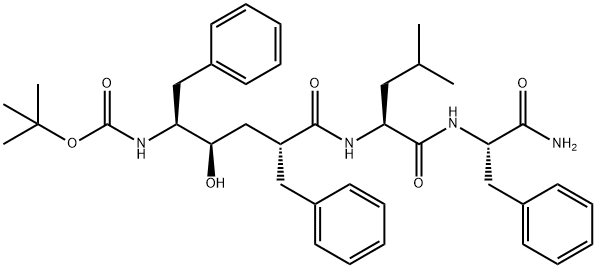N-[(2R,4R,5S)-5-[[(1,1-Dimethylethoxy)carbonyl]amino]-4-hydroxy-1-oxo-6-phenyl-2-(phenylmethyl)hexyl]-L-leucyl-L-phenylalaninamide, is a γ-Secretase Inhibitor, the enzyme complex that catalyzes the cleavage of the amyloid precursor protein (APP) to generate amyloid β-peptide (Aβ), the major causative agent in Alzheimer disease (AD).
L-685,458 has been used to attenuate Notch signalling in ovary culture. It has also been used to analyze the specificity of the γ-secretase activity in brain tissue samples.
ChEBI: L-685,458 is a peptide and carboxamide that is L-leucyl-L-phenylalaninamide, L-Leu-L-Phe-NH2, which has been acylated on the N-terminus by a Phe-Phe hydroxyethylene dipeptide isotere, 2R-benzyl-5S-tert-butoxycarbonylamino-4R-hydroxy-6-phenylhexanoic acid. Compounds based on the structure of L-685,458 are potent inhibitors of gamma-secretase, which mediates the final catalytic step that generates the amyloid beta-peptide (Abeta), which assembles into the neurotoxic aggregates in the brains of sufferers of Alzheimer's disease. It has a role as a peptidomimetic and an EC 3.4.23.46 (memapsin 2) inhibitor. It is a secondary alcohol, a peptide, a carbamate ester and a monocarboxylic acid amide. It contains a tert-butoxycarbonyl group.
Potent and selective γ -secretase inhibitor (IC 50 = 17 nM) that displays > 50-fold selectivity over a range of aspartyl, serine and cysteine proteases. Exhibits equal potency for inhibition of A β 40 and A β 42 peptides (IC 50 values are 48 and 67 nM respectively in human neuroblastoma cells). Also regulates CXCR4 and VEGFR2 expression through inhibition of Notch signaling in vitro .
L-685,458 mimics the transition state in aspartyl protease. It possesses an IC50 of 17nM with respect to inhibition of Aβ synthesis. It is known to block Notch (neurogenic locus notch homolog protein) signaling, which in turn reduces ERK (extracellular signal regulated kinase) phosphorylation by EGF (epidermal growth factor). L-685,458 targets the active site and substrate binding site of the enzyme.

